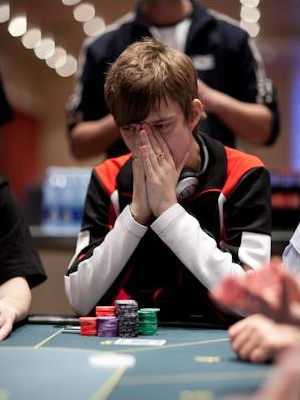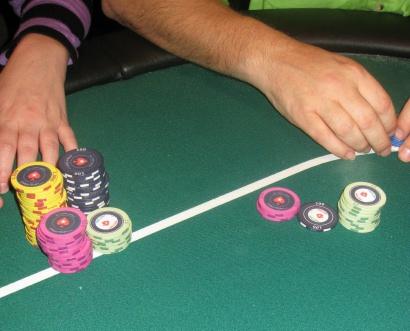|
|
 Pot odds and pot equity are similar
concepts, but there is an important distinction. Pot odds are a simple calculation players use to help them determine if they are
getting the correct odds to call a bet. Pot equity calculations, on the other hand, reveal how much the players hand is worth as a
percentage of the pot, based on the percentage of time that player will win the pot. Pot odds and pot equity are similar
concepts, but there is an important distinction. Pot odds are a simple calculation players use to help them determine if they are
getting the correct odds to call a bet. Pot equity calculations, on the other hand, reveal how much the players hand is worth as a
percentage of the pot, based on the percentage of time that player will win the pot.
POT ODDS
Put quite simply, pot odds are the ratio of pot size to bet size. If player A bets $1 into a $9 pot, player B would be forced to
call $1 in an attempt to win a $10 pot (the $9 pot plus the $1 player A bet), and therefore would receive pot odds of 10 to 1. In
this example, we have established that pot odds of 10 to 1 exist for player B, but we have not yet determined if player B has the
correct pot odds to make the call. That depends on the number of outs player B has. To determine this, we need to divide the total
number of unknown cards in the deck by the number of outs player B has. This will give us a ratio we can easily compare with the
odds the pot is yielding, which we already have established is 10 to 1. Lets say we are on the
turn, in a Holdem game, and player B has 8 outs. He
can see the four cards on the board and the two in his hand, leaving 46 unknown cards in the deck. As far as player B is concerned,
he has odds of 46 to 8 against making his hand on the
river, which reduces down to 5.75 to 1. To find out if player B has pot odds to make the call, we simply compare ratios. Player
B is getting pot odds of 10 to 1, but is only 5.75 to 1 against making his hand. Clearly, in this situation, player B has pot odds
to make the call.
But what if player A knows that he has the best hand, and does not want player B to have pot odds to draw out on him? Obviously,
player A cannot do anything about the odds (5.75 to 1 against) that player B will make his hand. What player A can do, if it is
a no limit, pot limit, or spread limit game,
is adjust the size of his bet, which will effectively reduce the odds the pot will yield. Imagine that in the example above, Player
A bets $3 into the $9 pot instead of betting only $1. Now player B would be forced to call $3 to try to win $12, for pot odds of
12 to 3, which reduces to 4 to1. Remember, player B is 5.75 to 1 against making his hand, but he is now only getting pot odds of 4
to 1. Now, player B is not getting the proper pot odds to make the call. This brings us to a crucial point. The amount player A
chooses to wager has a dramatic impact on whether player B receives the proper pot odds to call.
The question then becomes, is there a correct amount for player A to bet, and how much is that amount? To answer this, we should
consider the incentives of player A. Player A wants to maximize his profit from player B. He has player B in a tough spot, at
5.75 to 1 against to win the hand. The absolute worst thing player A can do is check (unless he is going for a
check raise). He wants to force player B to
put some money into the pot, as the odds are in his favor that he will win it. While betting anything will yield a better outcome than
checking, player A must also consider the pot odds he is giving to player B, when deciding on how much to bet. If he gives player
B the correct pot odds to make the call, he allows player B to make a call that is profitable, over the long run. This is profit
that Player A could have kept for himself if he had only bet enough to keep player B from calling with pot odds. So, we have
established that Player A shouldnt check, and he also shouldnt bet so little that player B has pot odds. If player A bets
$1.74 ($10 divided by 5.75), the approximate amount which yields pot odds of 5.75 to 1, it would not matter to player B if he called
or not, because he would get 5.75 to 1 on his money, but would be 5.75 to 1 against making his hand. This would result in a break even
scenario for player B over the long run. This bet would be sufficient to keep player B from making a profitable call and prevent
him from usurping any equity from the pot, but it would also deprive player A from making any return on his wager. Remember, player
A is a 1 to 5.75 favorite, and as such, would like to get as much action as possible from player B. So the answer to how much
player A should bet is: as much as he thinks player B will call, but not less than $1.75, and not so much that player B throws
his hand away. If player A can accurately predict the maximum amount player B will call, he can maximize his profit.
You can see that pot odds are a concern of both the bettor and the caller. This is especially true for pot limit and no limit play. In
these games, the bettor can control the pot odds their opponents receive by adjusting their bet amounts. In limit games, the bet
amount is fixed, which prevents the bettor from manipulating pot odds in this manner. Even so, bettors do manipulate the pot odds in
limit games quite frequently by raising. One reason players commonly raise on the flop in limit games is to knock out the players
behind them and to isolate the bettor. The reason
raising works as an isolation play is because it reduces the pot odds for the rest of the field, thereby reducing their incentive to
call.
POT EQUITY
 Similar to pot odds is the concept
of pot equity. The best way to understand pot equity is to think about the pot as a financial instrument, and the players who are involved
as a group of investors. The players own the pot in the same way a group of investors own a financial instrument. They share ownership,
with each owning a percentage, called equity. In a poker game, each player with a live hand has a chance to win the pot if they catch the
right cards, unless they are drawing dead. This means that each player has a vested interest in the pot, which we call equity. We know
that each player will catch the cards they need to win the pot a certain percentage of the time, and that their winning percentage is based
upon the number of outs they each have. The percentage of time that each player will win the pot can also be thought of as that players
ownership share, or equity, in the pot. Both pot odds and pot equity calculations are simply ways of telling you how much the pot is worth to you. Similar to pot odds is the concept
of pot equity. The best way to understand pot equity is to think about the pot as a financial instrument, and the players who are involved
as a group of investors. The players own the pot in the same way a group of investors own a financial instrument. They share ownership,
with each owning a percentage, called equity. In a poker game, each player with a live hand has a chance to win the pot if they catch the
right cards, unless they are drawing dead. This means that each player has a vested interest in the pot, which we call equity. We know
that each player will catch the cards they need to win the pot a certain percentage of the time, and that their winning percentage is based
upon the number of outs they each have. The percentage of time that each player will win the pot can also be thought of as that players
ownership share, or equity, in the pot. Both pot odds and pot equity calculations are simply ways of telling you how much the pot is worth to you.
Both pot odds and pot equity are straightforward calculations, based on specific inputs. Pot odds are a ratio of pot size to bet size.
In mathematical terms, that ratio is SP : SB, with SP = Size of the pot, and SB = Size of the bet. Pot equity is derived from the
probability a player will win the pot. That formula is a*b=E, with a = probability of winning, and b = size of the pot, and E = Equity
in the pot.
While pot odds and pot equity calculations are useful tools in the tool bags of winning players, there are limitations to their
usefulness. These limitations are due to the fact that we are only considering a limited amount of information in these
calculations, and are using them as a basis for deciding how much we should be willing to bet or call. Often, we have more information
than the basic inputs used in pot odds and pot equity calculations. This additional information is often highly relevant to our
decision making process, and we need a framework for considering it. For this, we use
implied odds.
See also: Fold Equity,
Equity
Previous Poker Term: Pot Limit
Next Poker Term: Presto |
|









